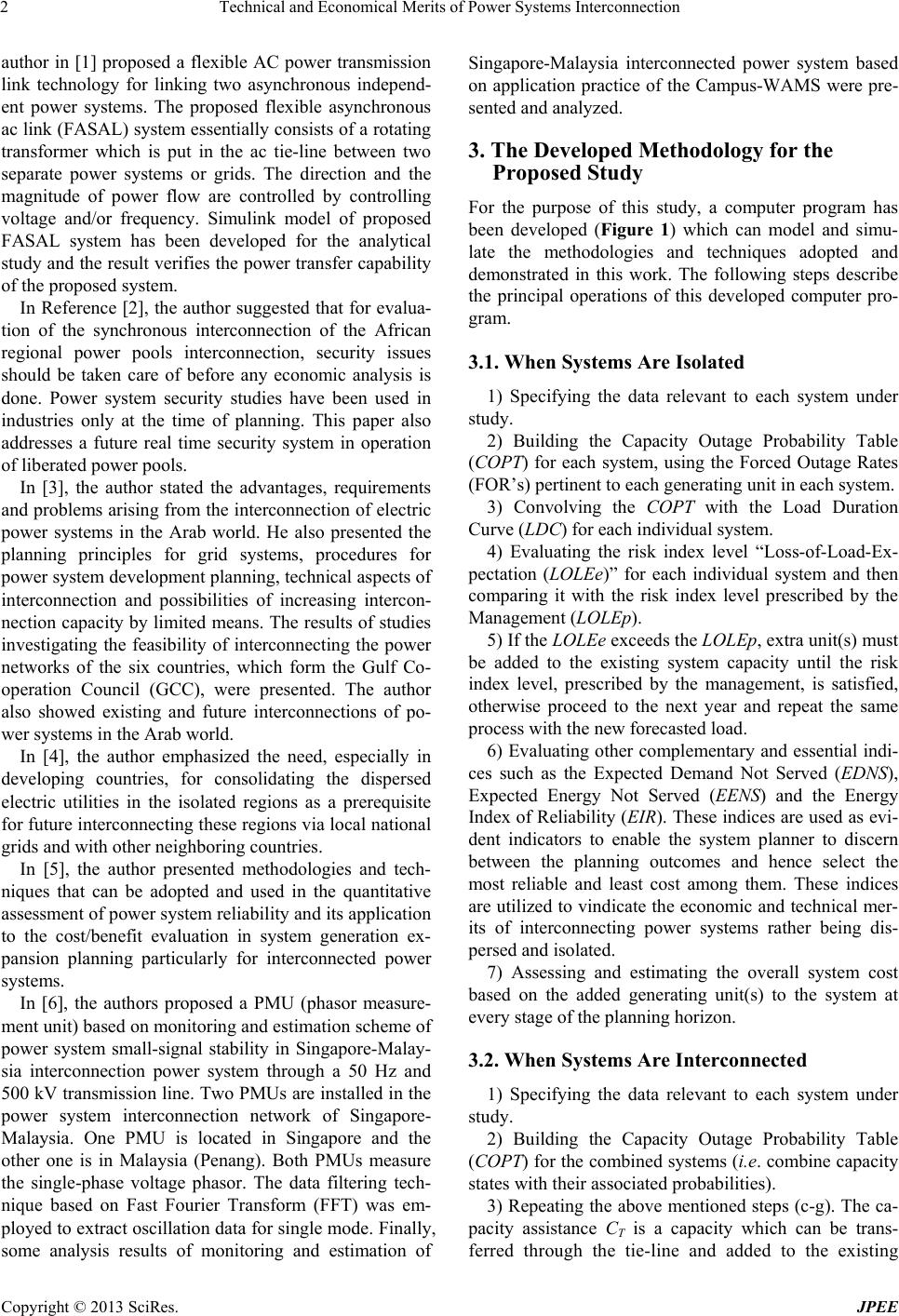
Technical and E c o n o mical Merits of Power Systems Interconnection
2
author in [1] proposed a flexible AC power transmission
link technology for linking two asynchronous independ-
ent power systems. The proposed flexible asynchronous
ac link (FASAL) system essentially consists of a rotating
transformer which is put in the ac tie-line between two
separate power systems or grids. The direction and the
magnitude of power flow are controlled by controlling
voltage and/or frequency. Simulink model of proposed
FASAL system has been developed for the analytical
study and the result verifies the power transfer capab ility
of the proposed system.
In Reference [2], the author suggested that for evalua-
tion of the synchronous interconnection of the African
regional power pools interconnection, security issues
should be taken care of before any economic analysis is
done. Power system security studies have been used in
industries only at the time of planning. This paper also
addresses a future real time security system in operation
of liberated power pools.
In [3], the author stated the advantages, requirements
and problems arising fro m the interconnection of electric
power systems in the Arab world. He also presented the
planning principles for grid systems, procedures for
power system development planning, technical aspects of
interconnection and possibilities of increasing intercon-
nection capacity by limited means. The results of studies
investigating the feasibility of interconnecting the power
networks of the six countries, which form the Gulf Co-
operation Council (GCC), were presented. The author
also showed existing and future interconnections of po-
wer systems in the Arab world.
In [4], the author emphasized the need, especially in
developing countries, for consolidating the dispersed
electric utilities in the isolated regions as a prerequisite
for future interconnecting these reg ions via local national
grids and with other neighboring countries.
In [5], the author presented methodologies and tech-
niques that can be adopted and used in the quantitative
assessment of power system reliability and its application
to the cost/benefit evaluation in system generation ex-
pansion planning particularly for interconnected power
systems.
In [6], the authors proposed a PMU (phasor measure-
ment unit) based on monitoring and estimation scheme of
power system small-signal stability in Singapore-Malay-
sia interconnection power system through a 50 Hz and
500 kV transmission line. Two PMUs are installed in the
power system interconnection network of Singapore-
Malaysia. One PMU is located in Singapore and the
other one is in Malaysia (Penang). Both PMUs measure
the single-phase voltage phasor. The data filtering tech-
nique based on Fast Fourier Transform (FFT) was em-
ployed to extract oscillation data for single mode. Finally,
some analysis results of monitoring and estimation of
Singapore-Malaysia interconnected power system based
on application practice of the Campus-WAMS were pre-
sented and analyzed.
3. The Developed Methodology for the
Proposed Study
For the purpose of this study, a computer program has
been developed (Figure 1) which can model and simu-
late the methodologies and techniques adopted and
demonstrated in this work. The following steps describe
the principal operations of this developed computer pro-
gram.
3.1. When Systems Are Isolated
1) Specifying the data relevant to each system under
study.
2) Building the Capacity Outage Probability Table
(COPT) for each system, using the Forced Outage Rates
(FOR’s) pertinent to each generating unit in each system.
3) Convolving the COPT with the Load Duration
Curve (LDC) for each individual system.
4) Evaluating the risk index level “Loss-of-Load-Ex-
pectation (LOLEe)” for each individual system and then
comparing it with the risk index level prescribed by the
Management (LOLEp).
5) If the LOLEe exceeds the LOLEp, extra unit(s) must
be added to the existing system capacity until the risk
index level, prescribed by the management, is satisfied,
otherwise proceed to the next year and repeat the same
process with the new forecasted load.
6) Evaluating other complementary and essential indi-
ces such as the Expected Demand Not Served (EDNS),
Expected Energy Not Served (EENS) and the Energy
Index of Reliability (EIR). These indices are used as evi-
dent indicators to enable the system planner to discern
between the planning outcomes and hence select the
most reliable and least cost among them. These indices
are utilized to vindicate the economic and technical mer-
its of interconnecting power systems rather being dis-
persed and isolated.
7) Assessing and estimating the overall system cost
based on the added generating unit(s) to the system at
every stage of the planning horizon.
3.2. When Systems Are Interconnected
1) Specifying the data relevant to each system under
study.
2) Building the Capacity Outage Probability Table
(COPT) for the combined systems (i.e. combine capacity
states with their associated probabilities).
3) Repeating the above mentio ned steps (c-g). The ca-
pacity assistance CT is a capacity which can be trans-
erred through the tie-line and added to the existing f
Copyright © 2013 SciRes. JPEE